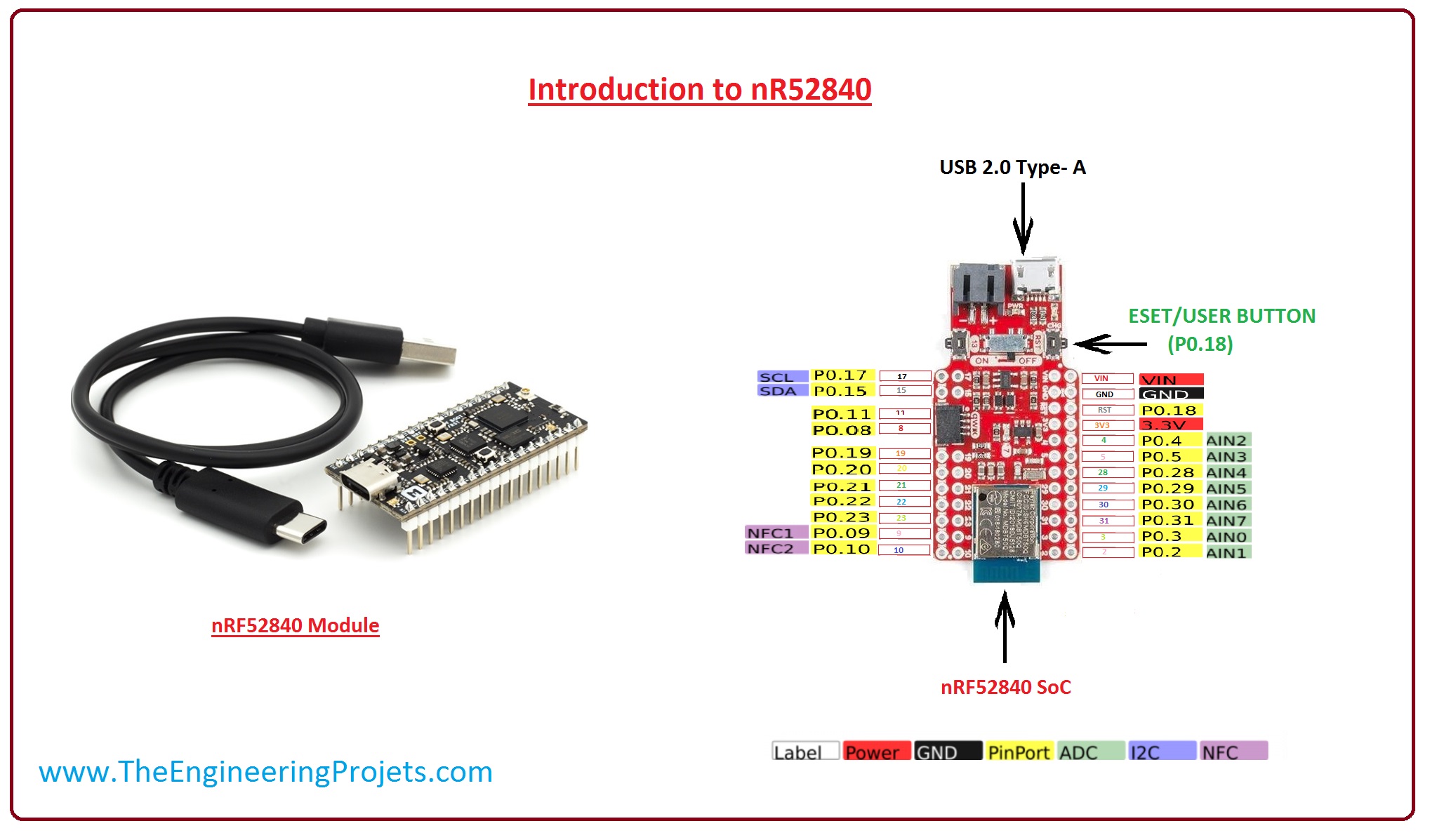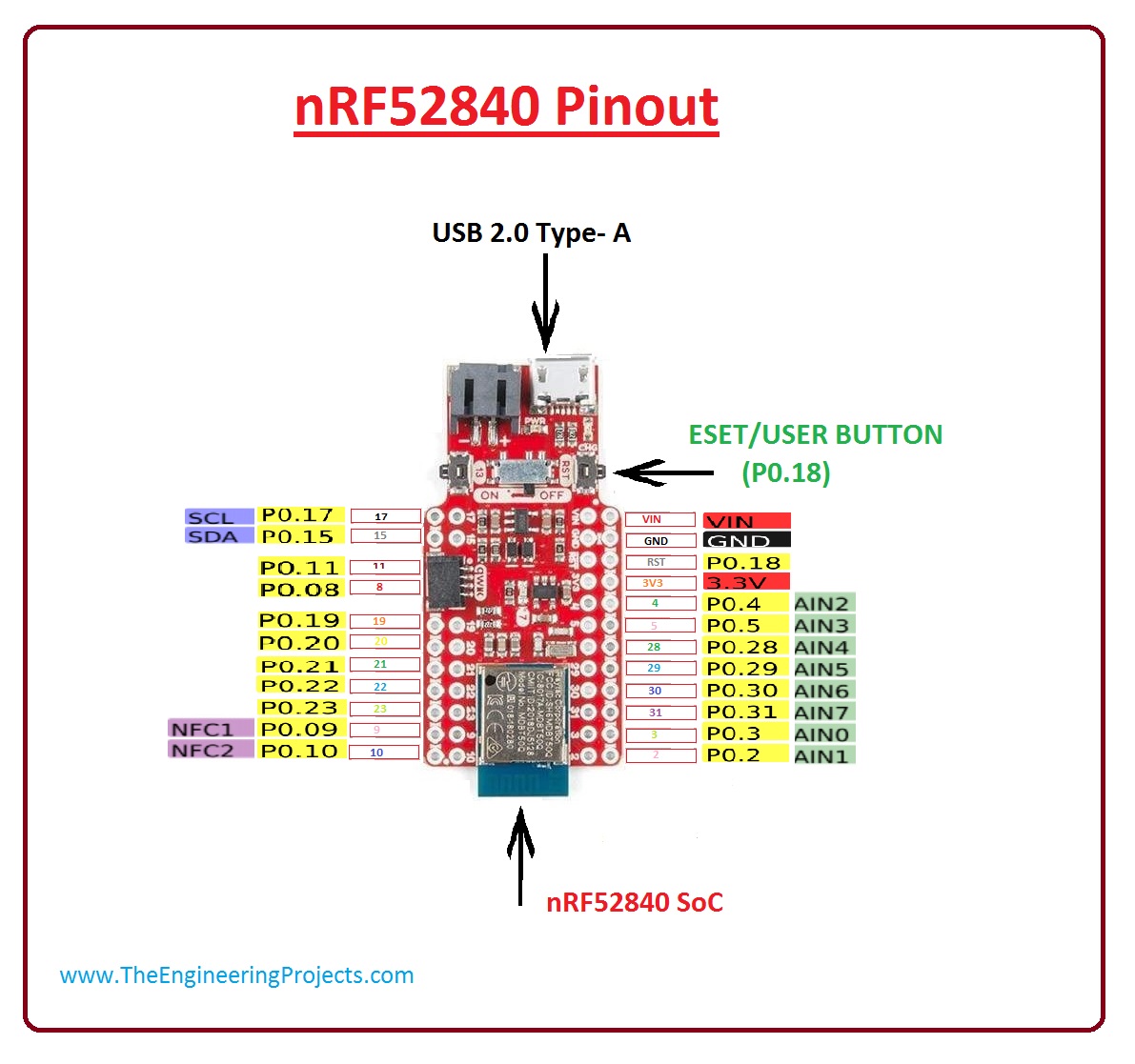
nRF52840 supports low energy Bluetooth, 802.15.4, ANT™ and user proprietary 2.4 GHz protocols. nRF52840 is used in different industrial projects such as industrial mesh networks, advanced personal fitness devices, and smart city infrastructure. In today's post, we will have a look at its working, specifications, applications, pinout, etc. I will also share some links where I have interfaced it with other microcontrollers. If you have any questions about it please ask in the comments, and I will resolve your queries. So, let's get started with a basic Introduction to nRF52840.
Introduction to nRF52840
- nRF52840 is a 2.4 GHz wireless system on chip (SoC). It integrates a multi-protocol 2.4 GHz transceiver, an Arm Cortex-M4F CPU and flash memory.
- It is an advanced and highly flexible single-chip solution for increasing demand for ultra-low power (ULP) wireless applications.
- It is designed with features of Bluetooth 5 such as long-range, throughput and inherent industry-grade security which are essential for today's applications. nRF52840 adds best-in-class security for the Cortex TM-M Series with an on-chip ARM Crypto Cell cryptographic accelerator.
- nRF52840 follows the same software and hardware architecture which is followed by nRF52 series (SoCs).
- Its core is an ARM Cortex M4F processor which solves quickly and more efficiently computation of complex functions for DSP, which requires floating point math.
- It has extensive memory available in both Ram and flesh, 256kB/1MB respectively. Combination of memory available and cortex M4F provides unparalleled capabilities for single-chip applications.
- The chip of nRF52840 consists of full speed (12Mbs) USB 2.0 controller and a large number of peripherals such as high-speed SPI (32 MHz) and quad SPI (32MHz) which allows direct interfacing to display and external memory sources.
- nRF52840 can operate from +5.5v to 1.7v supply voltage, which can also be provided from rechargeable batteries and USB supplies when there is no mains supply.
- nRF52840 is a Thread-certified module, which is ideal for home networking products using the thread mesh stack.
- Its radio supports 802.15.4 PHY and MAC layers making it perfect for additional stacks using 802.15.4 such as Zigbee.
nRF52840 Pinout &Description
Detailed information about nRF52840 pinout is given below. Lets, discuss them.| Pin# | Type | Description |
| A8 | P0.31 | It is a general purpose I/O pin. |
| A10 | P0.29 | It is a general purpose I/O pin. |
| A12 | P0.02 | It is a general purpose I/O pin. |
| A14 | P1.15 | It is a general purpose I/O pin. |
| A16 | P1.13 | It is a general purpose I/O pin. |
| A18 | DEC2 | This pin is used for 1.3 V regulator supply decoupling (Radio supply). |
| A22 | VDD | It is used for Power supply. |
| A23 | XC2 | It is a connection for 32 MHz crystal. |
| B1 | VDD | It is for Power supply. |
| B3 | DCC | It is DC/DC converter output. |
| B5 | DEC4 | It is 1.3 V regulator supply decoupling. |
| B7 | VSS | Ground. |
| B9 | P0.30 | It is a general purpose I/O pin. |
| B11 | P0.28 | It is a general purpose I/O pin. |
| B13 | P0.03 | It is a general purpose I/O pin. |
| B15 | P1.14 | It is a general purpose I/O pin. |
| B17 | P1.12 | It is a general purpose I/O pin. |
| B19 | P0.11 | It is a general purpose I/O pin. |
| B24 | XC1 | It is a connection for 32 MHz crystal. |
| C1 | DEC1 | It is 1.1 V regulator supply decoupling. |
| D2 | P0.00 | It is a general purpose I/O pin. |
| D23 | DEC3 | This pin is used for Power supply and decoupling. |
| E24 | DEC6 | It is 1.3 V regulator supply decoupling (Radio supply). |
| F2 | P0.01 | It isa general purpose I/O pin. |
| F23 | VSS_PA | Ground (Radio supply). |
| G1 | P0.26 | It is a general purpose I/O pin. |
| H2 | P0.27 | It is a general purpose I/O pin. |
| H23 | ANT | It is a Single-ended radio antenna connection. |
| J1 | P0.04 | It is a general purpose I/O pin. |
| J24 | P0.10 | It is a general purpose I/O pin. |
| K2 | P0.05 | It is a general purpose I/O pin. |
| L1 | P0.06 | It is a general purpose I/O pin. |
| L24 | P0.09 | It is a general purpose I/O pin. |
| M2 | P0.07 | General purpose I/O pin |
| N1 | P0.08 | It is a general purpose I/O pin. |
| N24 | DEC5 | It is 1.3 V regulator supply decoupling (flash supply). |
| P2 | P1.08 | It is a general purpose I/O pin. |
| P23 | P1.07 | It is a general purpose I/O pin. |
| R1 | P1.09 | It is a general purpose I/O pin. |
| R24 | P1.06 | It is a general purpose I/O pin. |
| T2 | P0.11 | It is a general purpose I/O pin. |
| T23 | P1.05 | It is a general purpose I/O pin. |
| U1 | P0.12 | It is a general purpose I/O pin. |
| U24 | P1.04 | It is a general purpose I/O pin. |
| V23 | P1.03 | It is a general purpose I/O pin. |
| W1 | VDD | It is a Power supply pin. |
| W24 | P1.02 | It is a general purpose I/O pin. |
| Y2 | VDDH | This pin used for High voltage power supply. |

Features of nRF52840
- Features of any electronic device can help us for a better understanding of the main functions associated with it. It will guide us on how we can select a relevant component for our projects. Following are some features of nRF52840.
- nRF52840 System-on-Chip consists of
- ARM Cortex M4F processor which used for ultra-low power operations.
- On this module, there are ports for Bluetooth 5, Bluetooth Mesh, Thread, ANT and 2.4 GHz proprietary.
- On this chip, there is a USB 2.0 (Full speed) controller and 1 MB FLASH and 256 kB RAM.
- On this chip for Debugging, there is an option such as MSC, CDC, and HID.
- This module has external low power 64-Mb QSPI flash memory.
- This module has a user programmable button and an RGB LED.
- It also has onboard 2.4G chip antenna.
- It also consists of U.FL connector selectable for an external antenna.
- It has a 3.3V regulator with 1A peak current output.
- This module has reversible USB 3.1 Type-C Connector.
- It is Breadboard friendly with dual 18-Pin headers.
- Its dimensions are 1.97" x 0.9" x 0.51" (50mm x 23mm x 13mm) with headers soldered in.
Applications of nRF52840
- These are some applications of nRF52840.
- It used in Smart Home products.
- It used in Industrial mesh networks.
- It also used in Smart city infrastructure.
- It used in Advanced wearables.
- It used in Connected watches.
- It used in Advanced personal fitness devices.
- It used in Virtual/Augmented Reality applications.
- It also used in Interactive entertainment devices
- It used in Advanced remote controls and Gaming controller.



